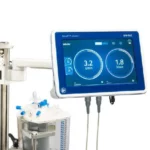
Revolutionizing Patient Care: SonoTT aQuila System Sets New Standard in Blood Flow Measurement
28 Mar 2024
Rotary sensors, also commonly referred to as angle sensors, are sensing devices that measure the rotational position of an object and provide a signal based on angular position. Rotary sensors are used in a wide range of applications, including automotive systems, robotics, and industrial machinery. Rotary sensors come in different types, technologies, and designs, each with its unique advantages and limitations.
Potentiometric Sensors (Rotary Potentiometers)
These rotary sensors use a resistive element that changes its resistance as it rotates. The resistance value is then measured to determine the angle of rotation. Potentiometric sensors are simple, inexpensive, and have a wide range of applications such as audio volume control, position control, and joystick applications.
More on Rotary Potentiometers >
Optical Encoders
Optical encoders use a light source and a photodetector to determine the angular position of a rotating object. The light source shines on a rotating disc, which has opaque and transparent segments that produce a series of pulses when the disc rotates. These pulses are then measured to determine the angle of rotation. Optical encoders are precise and have a high resolution, making them ideal for applications that require high accuracy, such as robotics and automation.
More on Rotary Encoders >
Magnetic Sensors
Magnetic sensors use a magnetic field to determine the angular position of a rotating object. The sensor and magnet are mounted separately – typically the magnet is mounted to the rotating object and the sensor is in a fixed position on the application. The sensor is able to detect changes in magnetic field as the magnet rotates, and converts this change into an output relative to angle. Magnetic sensors have no contact between the sensor and the moving part, so are ideal for applications that require high accuracy and reliability in harsh environments, such as aerospace and defense systems.
More on Magnetic Sensors >
Contact sensors rely on physical contact between the sensor and the rotating object to determine its position. These sensors are simple and inexpensive but are prone to wear and tear and may require frequent maintenance.
Non-contact sensors, such as optical and magnetic sensors, do not require physical contact with the rotating object. They are more reliable and require less maintenance than contact sensors, making them ideal for high-precision applications.
Automotive Systems
Rotary sensors are used in automotive systems, such as throttle position sensors, pedal position sensors, and steering angle sensors. These sensors help to ensure the safe and efficient operation of the vehicle.
Robotics
Rotary sensors are widely used in robotics to measure the position of joints and actuators. They provide feedback to the control system, allowing for precise control of the robot’s movement.
Industrial Machinery
Rotary sensors are used in industrial machinery to measure the position of machine components, such as shafts, valves, and actuators. They help to ensure the efficient operation of the machinery and prevent damage and downtime.